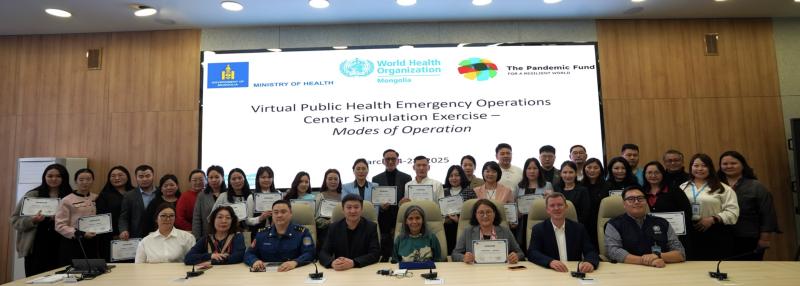
Strengthening Mongolia’s National Public Health Emergency Operations Centre through training and simulation exercises
Simulation Exercise
Western Pacific Region
Mongolia
In today’s unpredictable public health landscape, National Public Health Emergency Operations Centres (PHEOCs) are critical for timely, coordinated emergency responses. Beyond infrastructure, PHEOCs must be functional, with trained staff, tested systems, and clear operational procedures. Simulation exercises are among the most effective tools to assess and strengthen these capabilities.
On 28 February 2025, Mongolia launched its Public Health Operations Centre under the leadership of Minister of Health Dr. T. Munkhsaikhan with support of WHO and funded by the Pandemic Fund.
The PHEOC is a part of the broader public health systems strengthening initiative of Mongolia, post-COVID. Following WHO technical guidance and global best practice, the PHEOC work started in November 2024. The PHEOC is envisaged to be Mongolia’s hub for multisectoral evidence-based decision making for timely and effective preparedness and response to emergencies.
To continue its development process and to ensure capacity development in the country, WHO conducted training and virtual simulation exercises in Ulaanbaatar. The exercise brought together government stakeholders from across sectors to evaluate and enhance the country’s PHEOC functionality.
“This simulation exercise marks a critical step forward in strengthening Mongolia’s national capacity to respond to public health emergencies,” said Dr. L. Battur, Director General, Department of Public Health Policy, Ministry of Health. “By practicing the Watch, Alert, and Response modes in a realistic scenario, and with plans to roll out the training across the country, we are ensuring that our systems and people are ready to act swiftly and effectively when it matters most.”
Mongolia’s virtual simulation exercise
The five-day virtual simulation exercise engaged participants from the Ministry of Health (MOH), National Center for Communicable Diseases (NCCD), National Emergency Management Agency (NEMA), and other key ministries and agencies. The scenario tested Mongolia’s readiness to manage a complex, multi-sectoral public health emergency through a simulated disaster event leading to a measles outbreak.
A central focus was the testing of the three operational modes of the PHEOC — Watch, Alert, and Response. Watch Mode tested early warning, monitoring, and risk assessment capabilities. Alert Mode simulated escalation procedures and intersectoral coordination mechanisms. Response Mode involved the activation of full incident management and emergency coordination through the PHEOC.
Mongolia’s geographic vastness and seasonal climate challenges make virtual simulation a highly practical solution for nationwide training. “The simulation helped me clearly understand how and when the PHEOC should activate different modes. It was the first time I could see how my role fits into the bigger picture of national emergency coordination,” said Ms. D. Oyungerel, Epidemiologist at NCCD. “It made our responsibilities more concrete and actionable.”
Key training outcomes: Strengthening emergency response capabilities
With technical support from WHO and funding from the Pandemic Fund, the exercise achieved several important outcomes. It strengthened understanding and practical application of the three PHEOC modes, improved cross-sector communication and coordination, and highlighted critical gaps in standard operating procedures, the legal framework, and multi-sectoral coordination. Additionally, the exercise fostered collaboration among key institutions involved in emergency response.
To sustain momentum and institutionalize learning, the simulation exercise package will be translated into Mongolian and adapted to the national context. This localization will enable MOH to roll out the training across the country, reaching provincial and district-level actors. By embedding the simulation into national capacity-building efforts, Mongolia aims to ensure all relevant stakeholders are familiar with the PHEOC structure, operational modes, and emergency coordination mechanisms.
“What stood out to me was the collaboration between sectors — we were working in real time, just like we would during a real emergency,” said Dr. B. Gantulga, Director, Health and Social Welfare Department, Mongolian Red Cross Society. “This training gave us practical experience we can apply at the local level, especially when rolling it out to provinces.”
Next steps: Scaling up and sustaining PHEOC training nationwide
The virtual simulation exercise represents a milestone in Mongolia’s journey toward a fully functional and resilient PHEOC. By testing real-time emergency operations through a locally relevant scenario, and planning for nationwide roll-out, the country is taking a sustainable, system-wide approach to strengthening public health emergency preparedness.
With continued support from WHO and the Pandemic Fund, this model stands as a valuable example for other countries seeking scalable, context-adapted strategies to enhance national emergency coordination capacities.
“This exercise is a testament to Mongolia’s commitment to building a resilient public health emergency response system,” said Dr. Socorro Escalante, WHO Representative to Mongolia. “Under the leadership of Minister of Health Dr. T. Munkhsaikhan and with support from the Pandemic Fund, Mongolia has taken a proactive approach to emergency preparedness. WHO is proud to support this important initiative, which not only strengthens the national PHEOC but also ensures that frontline responders across the country are trained, prepared, and empowered to protect public health. This virtual simulation is just the beginning—the translation and rollout of the training package nationwide will ensure sustainability and long-term impact.”